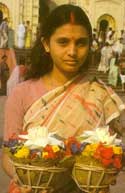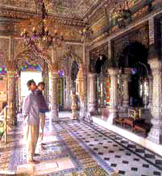|
The Bengal Brahmins are divided into five endogamous sub
castes:-Rarhi, Barendra, Vaidic, Saptasti and Madhyasreni and into numerous sub
divisions with
in each sub caste according to hereditary precedence and so-called purity of
blood. The Kayasthas are divided into four endogamous sub-castes:- Uttar-Rarhi,
Dakshin-Rarhi, Barendra
and Bangaja, with numerous sub divisions. The Vaidyas are
a numerically small community with a preponderant representation in the higher
professions and services. Notably members of all the three 'high' castes
are mainly Shaktas by religious persuasion while the majority of the lower
castes are Vaishnanavas of the Chaitanya cult and other cults. The essential ritual observances of the
Vaidyas, Kayasthas and the wealthier sub-castes of the 'lower' order closely
follow those of the Brahmins with additional observances inherited from the
aboriginal predecessors.
 The great majority of Hindus, constituting over three-fourths of the
community are lumped together as Sudras. The classical denomination of Sudras
covers all who follow occupations calling for manual labour. The demotion of the
great trading community, a hereditary group akin to the Vaisyas to the position
of Sudras was made by royal arbitrary command. They have their traditional
hierarchy and their endogamous and co-mensal groups, the clean Sudras enjoy the
services of Brahmins for their rites and worship and those in 'unclean'
occupations like scavenging, hide-curing etc are the real Harijans. The great majority of Hindus, constituting over three-fourths of the
community are lumped together as Sudras. The classical denomination of Sudras
covers all who follow occupations calling for manual labour. The demotion of the
great trading community, a hereditary group akin to the Vaisyas to the position
of Sudras was made by royal arbitrary command. They have their traditional
hierarchy and their endogamous and co-mensal groups, the clean Sudras enjoy the
services of Brahmins for their rites and worship and those in 'unclean'
occupations like scavenging, hide-curing etc are the real Harijans.
Within the Muslim community also a division is observable between families of
'pure' stock and the indigenous stock which forms the vast majority of the
Community. Similarly among the Christians, a firm line divides those who claim varying percentages of
European blood and those who are native converts mostly from the peasant stock.
Caste
consciousness has weakened and has ceased to be a substantial factor in public
life in Bengal. A powerful influence against caste distinctions was in operation
since the
early nineteenth century, when Ram Mohan Roy preached basic social and religious
reforms. He propounded Vedantic monotheism, abolition of caste and
communal division and pleaded for a society guided by rationalism. Closely after
him Ramakrishna Paramahamsa preached the gospel of a universal theism by
confirming the equal validity of all methods of religious enquiry. The moral and social implications of
Ramkrishna's teachings were forcefully brought out by his brilliant disciple Swami Vivekananda who brought
home to Bengal and India the realization that the days of the upper caste
were gone for ever and that the India of the future would arise out of those
very classes who were depressed. He aroused the elite enjoying caste privileges
to a realisation of the immortality, of depriving a large section of the people of their human right to equality. Rabindranath Tagore propounded a universal
faith which recognised no social barriers between man and man. The process was
given further impetus by Mahatma Gandhi's Campaign against caste and other
divisive social customs. religious
reforms. He propounded Vedantic monotheism, abolition of caste and
communal division and pleaded for a society guided by rationalism. Closely after
him Ramakrishna Paramahamsa preached the gospel of a universal theism by
confirming the equal validity of all methods of religious enquiry. The moral and social implications of
Ramkrishna's teachings were forcefully brought out by his brilliant disciple Swami Vivekananda who brought
home to Bengal and India the realization that the days of the upper caste
were gone for ever and that the India of the future would arise out of those
very classes who were depressed. He aroused the elite enjoying caste privileges
to a realisation of the immortality, of depriving a large section of the people of their human right to equality. Rabindranath Tagore propounded a universal
faith which recognised no social barriers between man and man. The process was
given further impetus by Mahatma Gandhi's Campaign against caste and other
divisive social customs.
|

